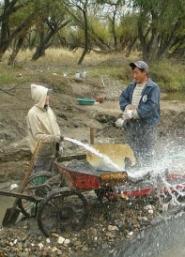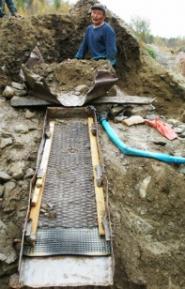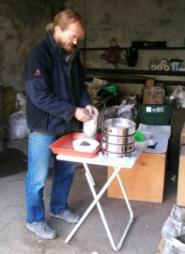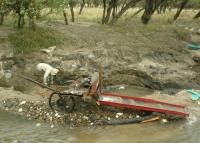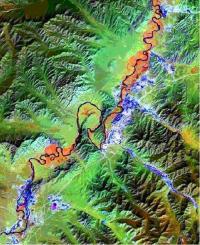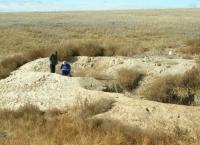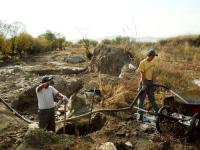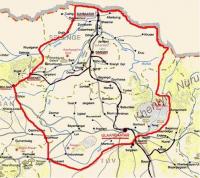MERCURY CONTAMINATION WITHIN THE SELENGE RIVER CATCHMENT
MONGOLIA – Assessment of environmental dangers caused by mercury contamination during exploitation of mineral deposits in the river Selenge catchment Administrative
Technical supervisor: RNDr. Martin Holý
Contractor: GEOMIN družstvo, Jihlava
Project manager: RNDr. Jiří Šourek
Cooperating organizations: Saint Mary´s University, Halifax
Mendel Agricultural and Forestry University, Brno
Cooperating organizations in Mongolia: Mongolian Technical University, Ulaanbaatar
Local authorities in the province of Selenge, Darchan, Bulgan and Toy
The project is financed from the state budget of the Czech Republic under the Official Development Assistance Program of the Czech Republic
BACKGROUND INFORMATION
About one hundred thousand people are presently believed to be involved in Mongolia in legal or mostly illegal mining activities. The majority of these seasonal workers are concentrated in ore districts with prevailing gold mining, whereas smaller part of miners is involved in extraction of fluorite and coal in the environs of Ulaanbaatar. Part of the production of small-scale mining comes from reworked tailings after active or shut down large-scale mining operations and some miners exploit small deposits that large mining companies take little interest in their exploitation. The volumes of extracted minerals differ considerably whether they come from weekend miners – teenagers with pan for gold washing over to family groups up to small-scale mechanical mining.
It is obvious that the majority of small miners who have not enough capital are using simple mining and mineral processing technologies and methods that have frequently negative impacts on the local environment and often result in endangering the health of local population and the miners themselves. The use of mercury in extraction of gold is the case of a model danger.
Identification of strong points and weaknesses of small-scale mining in Mongolia
Benefits of small-scale mining
|
Economic benefits |
Financial benefits for local and central economy |
|
Exploitation of small gold occurrences not viable for large-scale mining |
|
|
Rejuvenation of local market, offer of services for miners – manufacture and sale of relevant gear, potential market for herdsmen |
|
|
Reworking of tailings after large-scale mining, improvement of total recovery of gold |
|
|
Social benefits |
Job opportunities for population with poor education |
|
Alternative jobs for herdsmen families who due to restructuring of agricultural production or other reasons lost their resources for living |
|
|
Stabilization of local population, prevention of depopulation of countryside and migration to cities, Ulaanbaatar in particular |
Negative impacts of small-scale mining
|
Economic impacts |
Development of shadow economy |
|
Insufficient technical and technological support and protection of small-scale mining operations, low productivity of mining and mineral processing |
|
|
Missing state supervision of exploitation of mineral wealth of the country |
|
|
Social impacts |
Large migration of population into mining districts, concentration of population in areas with poor social environment and infrastructure |
|
Abandonment of existing style of living, i.e. extensive pasturage that secured stable resources for living of local population |
|
|
Insufficient social security and health care of small miners |
|
|
High safety risks connected with primitive small-scale mining operations |
|
|
Development of ghost settlements and social stress-related problems once the mining operations are terminated |
|
|
Negative by-products appearing in areas of small-scale mining – increased criminality, alcoholism, etc. |
|
|
Ecological impacts |
Uncontrolled use of mercury in gold extraction, high healthy risks, intoxication of biota by mercury |
|
Devastation of landscape |
|
|
Occupation of land useable for extensive pasturage, liquidation of resources of potable water and watering places for livestock |
|
|
Negative areal impacts on quality of surface waters, lower production of fish and negative influence on fish diversity |
|
|
Zero reclamation of mined out localities, absence of programs controlling closing down localities with shut down mining operations |
Specialists of local authorities and the Ministry of Nature and Environment of Mongolia have been trained during the project implementation at specific localities and mineral deposits, which represent relevant long-running ecological burdens due to high contents of mercury.
A) To assess the extent of contamination of alluvial sediments in flood plains and stream sediments by mercury through implementation of geo-ecological exploration and environmental evaluation of localities with existing or finished mining for placer gold deposits in central Mongolia
B) Analysis of utilization of mercury in mining industry of Mongolia and assessment of anticipated impacts of mercury contamination on bio-systems and human health
C) Training of Mongolian specialists and employees of local authorities ensuring the environmental protection. Transfer of methods of exploration, risk assessment and reclamation works including relevant instrumentation and technologies
D) Proposal of relevant environmental and ecological standards limiting the use of mercury in mining operations
THE PROJECT AREA
The eastern part of the large catchment of the river Selenge was selected as an area to be investigated in the territory of Mongolia. It includes sub-catchments of the most important southern tributaries – the rivers Orkhon and Tuul and eastern tributaries – the rivers Kharaa and Eroo.
A considerable part of Mongolian gold production comes from this region where the largest concentration of small-scale miners occurred since the mid nineties of the last century who through their activities intervene to various degree in the environment and who represent the decisive community using mercury during their mining activities. The most important historical and recent environmental impacts caused by mercury were identified in this region.





